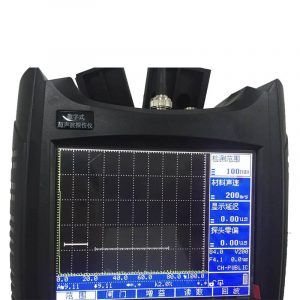超声波探伤仪: 无损检测的得力助手
在现代工业中, 产品的质量和安全至关重要. In order to ensure the integrity of materials and components, non-destructive testing technology came into being. 他们之中, the ultrasonic flaw detector as a powerful tool, widely used in the field of engineering, it can quickly and accurately detect the defects inside the material, thus ensuring the quality and safety of the product.

怎么运行的:
The principle of the ultrasonic flaw detector is based on the propagation and reflection of sound waves. 具体来说, it uses pulse reflection technology to emit ultrasonic waves through a probe into the interior of the object under test. When the ultrasonic wave encounters a heterogeneous interface (such as a defect), it is reflected. The reflected signal is received by the probe and forms an echo on the display screen. The height of the echo is related to the depth and size of the heterogeneous interface. The deeper the depth, the lower the defect echo, the smaller the defect, 反之亦然. This principle enables ultrasonic flaw detectors to accurately locate and evaluate internal defects without having to destructively inspect materials.
超声波探伤仪: 无损检测的得力助手
应用领域:
Ultrasonic flaw detector is widely used in industrial field. It can be used in the following industries and applications:
航天 – Used to detect cracks and fatigue damage in aircraft components to ensure the safe operation of aircraft.
Petrochemicals – Used to detect corrosion and cracks in pipes, tanks and equipment to prevent leaks and accidents.
制造业 – Used to detect defects in welds, castings and forgings to ensure the quality of manufactured products.
Metal processing – Used to detect cracks and pores in metal materials to ensure the performance of parts.
医疗的 – for medical imaging, such as ultrasound, for diagnosis and treatment.
Construction – Used to detect defects in concrete structures and ensure the safety of buildings.
Advantages and Application conditions:
超声波探伤仪: 无损检测的得力助手
The ultrasonic flaw detector has the following advantages:
Non-destructive testing: does not destroy the material, can be tested during the production process or product use.
高精准度: Small size defects can be detected to improve product quality control.
Multi-material applicability: Suitable for a variety of materials such as metals, composites and plastics.
Real-time detection: real-time display of detection results, improve work efficiency.
然而, ultrasonic flaw detectors also have applicable conditions, mainly including:
The material to be measured is a conductive material, such as metal.
超声波探伤仪: 无损检测的得力助手
The thickness of the measured object is not less than 4mm, and 6mm and above are generally recommended.
The structure of the object to be measured should not be too complex or irregular.
As an effective and accurate nondestructive testing tool, ultrasonic flaw detector provides important support for the industrial field. It helps companies ensure product quality, improve productivity, and reduce safety risks. When selecting and using an ultrasonic flaw detector, it is important to understand its principle, application field and applicable conditions in order to fully realize its potential and ensure the quality and safety of the product. Ultrasonic flaw detectors have become a powerful assistant in the field of modern engineering, helping all walks of life to achieve greater success.
